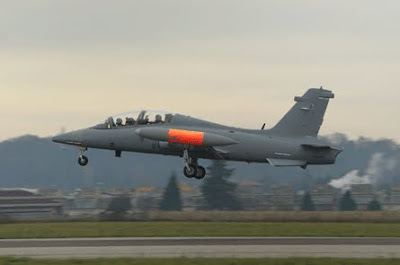12 Desember 2009
 Su-30MKM (photo : Paul Si)
Su-30MKM (photo : Paul Si)Air Force Flaps its Wings
The most potent weapon in the arsenal of the Royal Malaysian Air Force (RMAF), or Tentera Udara Diraja Malaysia (TUDM), is the Russian-built Su-30MKM multirole fighter. A $934.9 million agreement was signed in 2003 for 18 fighters, with the last batch of six delivered on 17th August 2009. This batch had been delayed because of contractual disputes over avionic integration problems on the twelve aircraft already handed over.
Despite receiving new Russian fighters, the RMAF needs at least 18 further multirole fighters, with the Gripen, Rafale and Super Hornet all considered contenders. The RMAF is allegedly keen on the F/A-18F Super Hornet to equip its second multirole squadron, which could augment eight F/A-18D Hornets already in service. Other commentators advise more Su-30MKMs to establish a standardised fighter fleet. Following a review of whether an upgrade was feasible, the RMAF has decided to progressively withdraw all 14 MiG-29N fighters by the end of 2010.
The RMAF, like the MAF as a whole, faces particular problems relating to government policy. The government mandates foreign defence procurements must be done via registered Bumiputera companies owned by Malays. This means new equipment and spare-part acquisitions must be done through local middlemen, their commission duly adding to the cost. The end result is a lack of spares and support equipment due to artificially inflated prices and a lack of funds. Furthermore, these brokers do nothing to advance offsets that would help the local defence industry. A problem peculiar to the TUDM is a mix of Western and Russian aircraft that does little to simplify the logistics chain.
 MB-339CM (photo : FlightGlobal)
MB-339CM (photo : FlightGlobal)
Malaysia has a 4,800km coastline requiring regular surveillance, one method of which is by aerial reconnaissance. Serial production of the ALUDRA Mk.I Unmanned Aerial Vehicle (UAV) is to proceed in 2010, despite the need for design improvements. Developed by Unmanned Systems Technology (UST), the 150kg ALUDRA has a 150km range and six-hour endurance. Its surveillance payload will no doubt require overseas cooperation, even as development of the Mk.II ALUDRA is gathering pace.
The RMAF received the last of its eight Alenia Aermacchi MB-339CM advanced/lead-in trainers from Italy in late 2009. The first two aircraft arrived in March 2009, and these will eventually replace MB-339AM trainers. The Pilatus PC-7 Mk II will replace 34 existing PC-7 basic trainers. Tragically, two pilots were killed in a PC-7 crash at Langkawi on 11th September 2009. Malaysia ordered four Airbus A400M transport aircraft in 2005 for delivery in 2013. However, considering the A400M programme’s troubles, Malaysia may well be rethinking its options.
Replacement of the 40-year-old S-61A-4 Nuri helicopter fleet has been a long-running saga, reignited by a fatal crash in July Despite receiving new Russian fighters, the RMAF needs at least 18 further multirole fighters, with the Gripen, Rafale and Super Hornet all considered contenders 2007. Thus far, 89 people have been killed in 15 Nuri accidents. A tender was issued in December 2007 and the Eurocopter EC725 Cougar was duly selected for airmobility and search-and-rescue roles. An LOI was issued for an initial batch of twelve Cougars, with an additional 15 or so slated for 10MP. In a sudden reversal, the government announced it was aborting the Cougar deal on in October 2008. The reason given was financial difficulties, although the selection process had drawn criticism for being overpriced, probably due to mark-ups by local Bumiputera agents.
 Aludra UAV (photo : Zulkhas)
Aludra UAV (photo : Zulkhas)
To rectify its weak air-defence umbrella, the MAF needs a comprehensive radar network plus medium/long-range Surface-to- Air Missiles (SAM). At one stage the Chinese KS-1A was mooted as a candidate, but it apparently did not live up to modern expectations. The KS-1A option subsequently faded into oblivion. Alternative systems are the Buk-M1-2, Aster 30 SAMP/T and Hawk-AMRAAM.
Up to eight low-cost Airborne Early Warning & Control (AEW&C) aircraft are eminently desirable to improve situational awareness for the fighter fleet, but these remain out of reach due to budgetary constraints. They remain on the table for 10MP and 11MP, however. The RMAF lists contenders like the Embraer EMB-145 SA, Boeing E-2C Hawkeye 2000, Israeli G550 Phalcon and Saab 2000 Erieye. In December 2008, the RMAF Chief, General Ariffin, said the AEW&C procurement would be the next big-ticket item after more multirole fighters had been bought.
Conclusion
To transform into a conventional force, the MAF has purchased new equipment to counter asymmetric threats and sustain traditional rivalries with neighbours like Singapore. However, Malaysia’s defenceprocurement policies are often chaotic, and the MAF has ended up with an international hodgepodge of equipment. Some recent acquisitions reveal serious deficiencies relating to integration of Western and Russian systems, most obviously in the fighter fleet. While indigenous production is commendable in a quest for self-reliance, the country at times overextends itself. Perhaps the current recession will give the Malaysian government time to pause and assess what its priorities are, as some recent acquisitions seem to have been motivated more by politics than by defence needs. The MAF faces truly Asian challenges, and will no doubt come up with truly Asian solutions.
(Asian Military Review)











Tidak ada komentar:
Posting Komentar